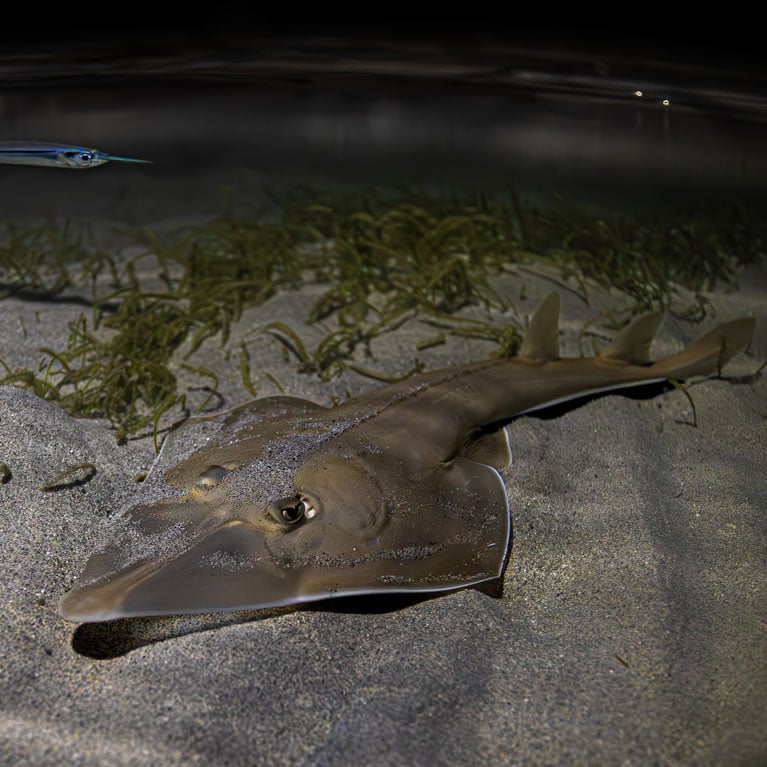Nurseries for giant guitarfish of the Andaman Islands
Evan is searching the shallow waters of India’s Andaman Islands to find the habitats that Critically Endangered giant guitarfish and other vulnerable rays use to pup and where their young grow up. He hopes that by addressing some of the key gaps in knowledge about how these rays live, his work can guide more effective protection for these species and their essential habitats.
As a kid I dreamed of pursuing a career in wildlife conservation until I volunteered on a Save Our Seas Foundation project, when I realised the importance and urgency of shark and ray conservation in India. Especially given that the country is a major contributor to the world’s shark and ray fisheries, it was worrying to see the diversity and sheer number these species at local fish markets, regardless of their life stage or threatened status.
Since then, I have pursued shark and ray research and use my findings to raise awareness of the plight of these...
Characterizing potential nursery habitats for giant guitarfish and other rays.
To determine what makes the shallow coastal waters of the Andaman Islands important nurseries for endangered giant guitarfish and rays and to use these characteristics to identify more such nurseries. We will also use these findings to highlight nurseries that require urgent conservation measures.
The Critically Endangered giant guitarfish and other heavily fished rays are still not protected under the Indian Wildlife (Protection) Act. This is often due to lack of knowledge pertaining to their status, requirements and distribution, which makes it difficult for administrations to plan and enforce conservation measures. This project aims to determine critical habitat requirements and threats to juvenile giant guitarfish and other rays in the Andaman Islands, which could help to direct conservation efforts.
India supports one of the world’s largest shark and ray fisheries and this has led to drastic population declines of already threatened members of this group, such as giant guitarfish and some rays. Despite these worrying trends, these species remain unprotected under the Indian Wildlife (Protection) Act and continue to be exploited in the country’s waters.
The lack of biological and ecological information about these species is one of the factors hindering their conservation. By identifying locations that are important to their survival, we can direct conservation initiatives to protect more effectively the species and the habitats they depend on. The Andaman Islands represent one of these locations. Studies from the islands have highlighted the diversity of giant guitarfish and other rays in these waters and have also shown that the juveniles of some species aggregate in shallow coastal waters. Given the rapid development that the islands are going through, it is important to identify and characterise how species use the habitats in these coastal regions before they are lost along with the species that depend on them. This assessment will also provide data that could facilitate the addition of these species to the Indian Wildlife (Protection) Act.
Although the conservation of sharks and rays in India is still in its infancy, a similar approach to what we propose has been well received and already implemented for sea turtle conservation. Turtle nesting beaches across the country have been designated as protected areas and receive focused conservation attention that has helped to protect the turtles and the coastal areas they depend on.
- To provide estimates of the number of juvenile giant guitarfish and other rays at aggregation sites across the Andaman Islands. This will help us compare to what extent each site contributes to these species’ local populations and prioritise the importance of these locations to the species.
- To characterise each of the above-mentioned sites and identify key habitat features that are common to sites that support a high abundance of juvenile giant guitarfish and rays. This will be used to identify new sites with the same habitat characteristics and we will conduct surveys to determine if they also support a high abundance of these species.
- To assess the magnitude of human disturbance at each site and try to evaluate the effect that it may have on the number of juvenile giant guitarfish and rays at the sites.


